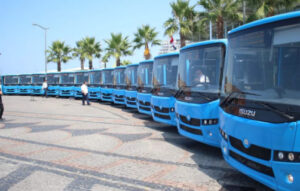
An outbreak of foot-and-mouth disease has been reported in Hungary, which has led to emergency measures in a number of countries. The authorities of the UK, Russia and Ukraine have already announced restrictions on imports of animals and animal products from Hungary to prevent the spread of the dangerous virus.
Today, Ukraine has imposed a ban on the import of animals susceptible to the foot-and-mouth disease virus, as well as raw materials and animal products from such animals. The State Service of Ukraine for Food Safety and Consumer Protection (SSUFSCP) explained that the measures were taken to avoid the introduction of the virus into the country. According to the agency, the source of infection can be not only infected animals, but also those in the incubation period. In addition, the virus is transmitted through products obtained from infected animals.
The competent authorities in each country continue to monitor the epizootic situation and are ready to introduce additional measures if necessary.
Foot-and-mouth disease is a highly contagious viral disease that affects farm animals such as cattle, pigs, sheep and goats. It is characterized by the appearance of ulcers and blisters in the mouth, hooves and udders of animals, accompanied by fever and a sharp decline in productivity.
The disease is spread by airborne droplets, through feed, water, clothing and equipment, and can also be transmitted through animal products. Although foot-and-mouth disease is rarely transmitted to humans, it causes significant damage to agriculture, leading to massive livestock losses, strict quarantine measures, and serious economic losses. Due to the high contagiousness of the disease, international veterinary services closely monitor outbreaks and take strict measures to prevent its spread.

As of January 31, 2025, 4 million 285.61 thousand non-EU citizens who fled Ukraine as a result of the full-scale Russian invasion had temporary protection status in the EU, an increase of 25.53 thousand in January compared to 25.59 thousand in December, Eurostat reports.
“The largest absolute increase in the number of beneficiaries was observed in Germany (+8,800; +0.8%), the Czech Republic (+6,4360; +1.6%) and Spain (+3,050; +1.3%),” the agency said.
It is noted that the number of people under temporary protection in January decreased in Denmark (-2,245; -6.1%), France (-660; -1.1%), Austria (-420; -0.5%) and Lithuania (-155, -0.3%).
According to Eurostat, Germany remains the country with the largest number of refugees from Ukraine in the EU and the world by a growing margin – 1 million 170.25 thousand at the end of 2024, or 27.3% of the total number of beneficiaries in the EU.
The top three also includes Poland – 993.02 thousand, or 23.2%, and the Czech Republic – 394.99 thousand, or 9.2%.
They are followed by Spain (229.67 thousand) and Romania (181.9 thousand) with a significant lag.
There is no data for January for Italy and Portugal, where at the end of 2024 there were 163.10 thousand and 65.29 thousand refugees with this status, respectively. In recent months, Eurostat has also clarified that the data for Spain, Greece, and Cyprus take into account some people whose temporary protection status is no longer valid.
According to the agency, compared to the population of each EU member state, the largest number of temporary protection beneficiaries per thousand people at the end of January 2025 was observed in the Czech Republic (36.2), Poland (27.1) and Estonia (26.0), while the corresponding figure at the EU level is 9.5.
It is also said that as of the end of 2024, Ukrainian citizens accounted for more than 98.4% of the beneficiaries of temporary protection. Adult women accounted for almost half (44.8%) of temporary protection beneficiaries in the EU, children for almost a third (31.8%), while adult men accounted for less than a quarter (23.4%) of the total. A year earlier, the share of women was 46.1%, children – 33.2% and adult men – 20.7%.
More than 100 thousand people with temporary protection status at the end of January 2025 were also in Slovakia – 132.64 thousand, the Netherlands – 122.21 thousand and Ireland – 110.58 thousand.
Between 50 thousand and 100 thousand of them were in Belgium – 88.29 thousand, Austria – 85.14 thousand, Norway – 79.56 thousand, Finland – 69.98 thousand, Bulgaria – 70.34 thousand, Switzerland – 68.40 thousand and France – 57.87 thousand (data on children are mostly not included – Eurostat).
This is followed by Latvia – 48.54 thousand people, Lithuania – 48.10 thousand, Sweden – 47.02 thousand, Hungary – 39.33 thousand, Estonia – 35.72 thousand, Denmark – 34.68 thousand, Greece – 32.81 thousand, Croatia – 26.15 thousand, Cyprus – 22.46 thousand, Luxembourg – 3.94 thousand, Iceland – 3.91 thousand, Malta – 2.24 thousand and Liechtenstein – 0.71 thousand.
Eurostat clarified that all the above data relate to the granting of temporary protection on the basis of EU Council Decision 2022/382 of March 4, 2022, which establishes the existence of a massive influx of displaced persons from Ukraine due to Russia’s military invasion and entails the introduction of temporary protection. On June 25, 2024, the European Council decided to extend temporary protection for these persons from March 4, 2025 to March 4, 2026.
According to updated UNHCR data, the number of Ukrainian refugees in Europe as of February 19, 2025, was estimated at 6.346 million, and 6.907 million worldwide, which is 43 thousand more than on January 16.
In Ukraine itself, according to the latest UN data, 3.665 million internally displaced persons (IDPs), including approximately 160,000 people, were displaced from the frontline areas in the east and south between May and October 2024 due to the intensification of hostilities.
As Deputy Economy Minister Serhiy Sobolev noted in early March 2023, the return of every 100,000 Ukrainians home results in a 0.5% increase in GDP. In its January inflation report, the National Bank estimated the outflow from Ukraine in 2024 at 0.5 million (0.315 million according to the State Border Guard Service). The NBU also maintained its forecast of outflows in 2025 at 0.2 million.

Agro-Region agricultural holding has started spring field work, its press service reported on Facebook.
“All clusters have started working, in particular, we are leveling the main tillage method – ‘moisture closure’. Crops have resumed vegetation, we are monitoring their condition to further develop care measures and monitor for pests,” said Yuriy Lysak, chief agronomist of the agricultural holding.
He noted that over the past five years, there has been a lack of moisture reserves in the one-meter soil layer. The main reason is insufficient precipitation in the fall and winter.
“In particular, from September 1, 2024, to March 1, 2025, less than 200 mm fell, although in the best years 360-400 mm fell. The situation was similar in 2020 and 2022. This is not critical for the company, because we know how to act in such situations,” the expert summarized.
Agro-Region owns a land bank of 39 thou hectares in Kyiv, Chernihiv, Zhytomyr and Khmelnytsky regions. It specializes in crop production. It consists of 11 companies organized into four crop production clusters. It has two elevators – Boryspil elevator with a capacity of 73 thousand tons and Miropil elevator with a capacity of 52 thousand tons.
Agro-Region’s annual harvest of grains and oilseeds is 200 thousand tons.
In April 2021, the Swedish company Lobiu Sala AB, owned by former Minister of Economy of Ukraine Aivaras Abromavičius, received permission from the Antimonopoly Committee of Ukraine to buy the Swedish Agro Region Stockholm Holding, which manages the Agro-Region group of companies in Ukraine.

Cherkasy Bus JSC, according to preliminary data, ended 2024 with a net profit of UAH 122.08 million, which is 33% less than in 2023, according to the information on the agenda of the company’s general meeting of shareholders for the previous year.
According to the draft decision of the meeting scheduled for April 11, the shareholders intend to leave 95%, or UAH 115.98 million, of the profit at the disposal of the company, and 5% (UAH 6.1 million) to be allocated to the reserve fund.
As reported, based on the results of 2023, the shareholders of Cherkasy Bus also allocated net profit for development.
The meeting will, in particular, approve the planned profit target for 2025 in the amount of UAH 102.84 million.
According to Cherkasy Bus, as of the beginning of 2025, its retained earnings amounted to UAH 267.28 million (UAH 151.3 million a year earlier).
In 2024, the company’s assets increased by 40.6% compared to 2023 to UAH 1 billion 132 million, including total receivables, which decreased by 7.7% to UAH 315.7 million, while inventories increased by 74.5% to UAH 658.1 million.
The company increased its current liabilities by 51.4% to UAH 543 million and long-term liabilities by 17.3% to UAH 137.1 million.
Net profit per share of UAH 2 amounted to UAH 1.5, compared to UAH 2.24 a year earlier.
Founded in 1994, Cherkasy Bus produces small class Ataman buses (including school buses) and other wheeled vehicles based on Japanese Isuzu units.
According to Clarity-project, in 2024, the company increased its net income by 2.6% compared to 2023, to UAH 1 billion 771 million.
According to the NSSMC, as of the third quarter of 2024, Oleksandr Dorosh, head of the Isuzu-Ataman Ukraine business, owns almost 42.29% of the shares of Cherkasy Bus, three individuals, including longtime Chairman of the Board Vitaliy Raabe, own 7.9275% each, and two more – almost 5.4% and 8.25%.
The authorized capital of the company is UAH 162.97 million.